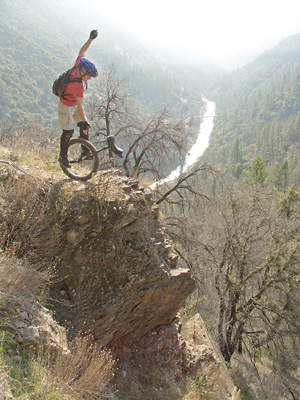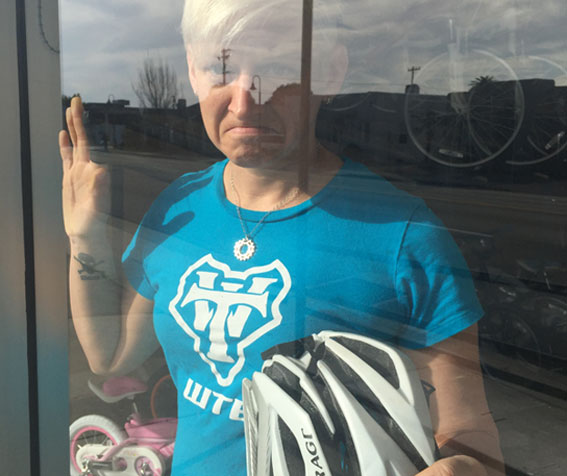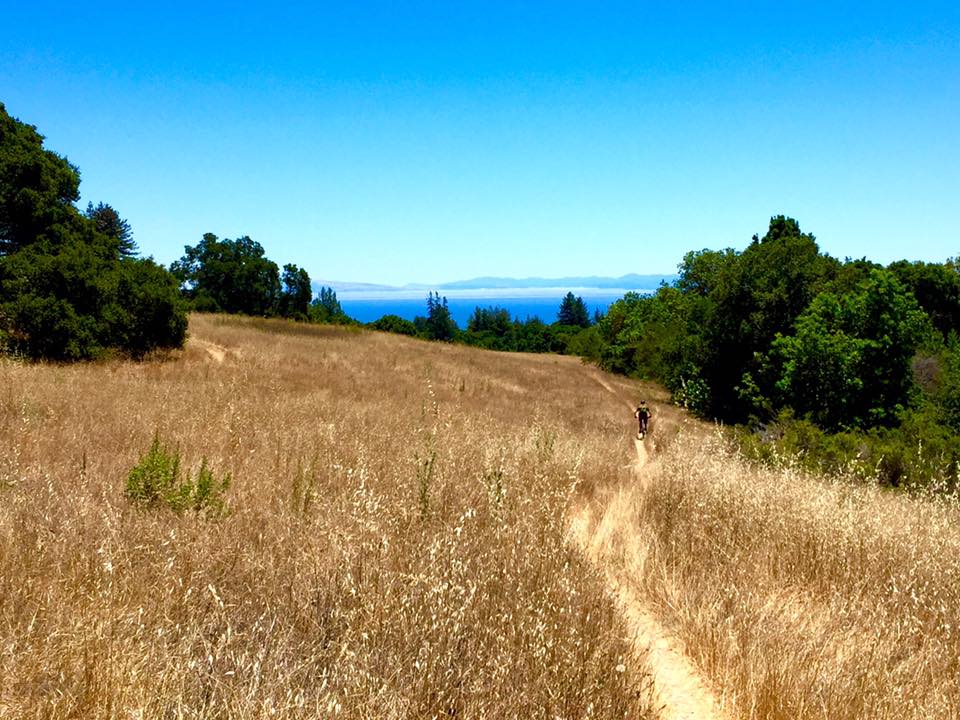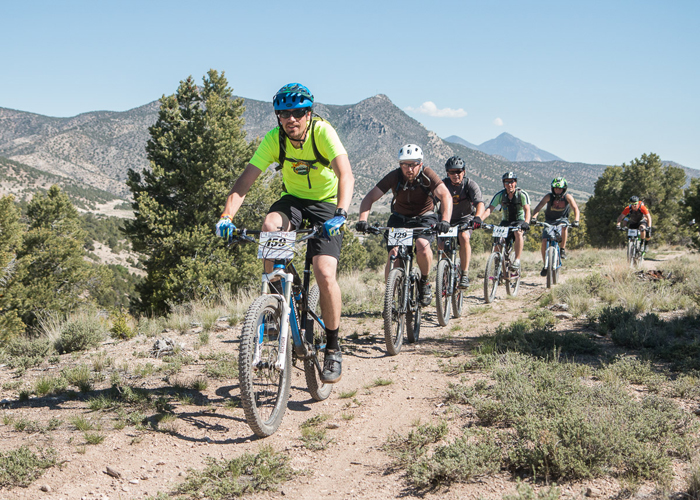- Tahoe’s Nevada Beach Tops the List of Hard-to-Book Campgrounds - 07/17/2024
- Cannabis Watershed Protection Program Cleans Up Illegal Grow Sites - 07/10/2024
- French Fire - 07/05/2024
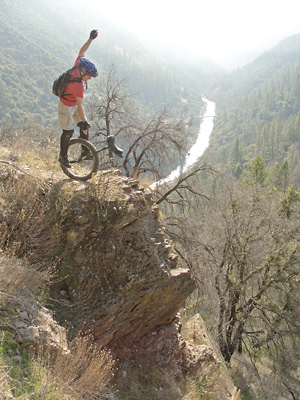
Nor Cal Mountain Unicyclists Find Few Places They Can’t Tread
By Christa Fraser
Corbin Dunn doing a “seat drop.” Photo by John Foss.
“First off, people can’t be posers,” Corbin Dunn says.
Riding a 36” fat-wheeled Coker unicycle, Dunn powers up a steep road in Los Gatos on a weeknight ride with a motley contingent of mountain unicyclists. The lone wheel is enormous. He powers up hill faster than a typical mountain biker. On the descents, his legs spin madly, trying to keep his feet on the pedals. He has broken his “handlebar,” a small carbon-fiber nub under his seat. Regardless, he aims for a berm on the side of the road. He bails at the last second, falling nearly four feet off his perch. He remounts in one fluid succession of movements.
“People can’t simply pick up a unicycle and stand on it,” he says. “They have to dedicate at least 10 hours to learning how to simply ride the thing.”
A YouTube Favorite
People seem equally parts in awe of and confused by unicyclists, especially on singletrack. Passing cyclists shout out predictable comments and questions:
“Where’s your other wheel?”
“Hey, I think you lost something.”
To which unicyclists often respond: “I just got rid of my training wheel.”
Mountain Unicycling, or MUni for short, hasn’t exactly reached mainstream status. But thanks to YouTube and the Banff Mountain Film Festivals, MUni has recently gained some wider exposure. “MUni has probably attracted more press than any other form of unicycling,” says John Foss, founder of California MUni Weekends, a festival held every year since 1996.
YouTube star and Vancouver native Kris Holm has brought MUni much of its notoriety. “If unicycling has a Tony Hawk, it’s him,” says Foss. With a mix of trials, freeriding and downhill techniques, Holm has shown that unicycles can go anywhere a bicycle can go—and many places bikes can’t. Vertigo-inducing videos of Holm riding sheer granite ledges and bumping urban trials moves around his town have received millions of hits on YouTube.
Nathan Hoover, a Los Gatos engineer, has ridden in Bhutan and Mexico with Holm. The films of their adventures, Into the Thunder Dragon, about their trip to Bhutan, and Unizaba, which recorded their descent of the third highest mountain in North America, Mexico’s El Pico Del Orizaba, demonstrate that mountain unicycles can hold their own in any terrain.
“We can stop on a dime, go backwards, spin on one spot, hop up stairs and curbs,” Foss enthuses.
Essentially a unicycle operates in a 360-degree groove.
One-Wheel Mini Revolution
No one is certain exactly how unicycling got its start. But an early prototype unicycle may have been created when cyclists began to remove the micro rear wheel from their penny-farthing bikes in the late 1800s. They found the enormous front wheel was sufficient, while the rear wheel was merely a hazardous nuisance. However, many riders give credit to Alaskan George Peck for really getting mountain unicycling rolling in the late 1980s.
In the mid-‘80s, Peck, considered the “grandfather of MUni,” started riding his unicycle on some of the local dirt roads and offroad unicycling was born.
A decade later in California, Foss discovered great MUni riding on the trails around Sacramento and Auburn. He got the idea to hold an “all-dirt convention” and the MUni Weekends were born. The movement picked up momentum when Bruce Bundy, an engineer from Santa Cruz, met Peck in 1997 and watched Peck’s video, Rough Terrain Unicycling. Interest grew and there is now a tight-knit group of riders in Nor Cal.
Unicycles used for mountain riding at the time were typically made with either a 24” or 26” wheel, which were versatile on technical singletrack but inefficient over long distances. Then, in the late ‘90s, Coker Cycling Company released a 36” unicycle, which greatly improved their suitability for long distance trail riding (and helped to make up for the fact that unicycles don’t have gears). The enormous wheel allows riders to cruise long cross-country distances and still roll over reasonably rough terrain.
With their new cross-country rigs, Hoover and Bundy joined the small but growing trend of unicycle touring. Recent trips include pedaling the Great Wall of China, the Swiss Alps, Laos and the Mediterranean. Locally, many of the riders have pedaled the circumference of Lake Tahoe.
But unicycle touring isn’t what’s garnered the most attention for the sport. “People realized they could use the unicycle to hop over things and trials emerged,” Dunn says. “Next, people decided to combine trials and freestyle riding to (become) street riding.”
Physics and equipment limits unicyclist from performing some of the tricks we’re used to seeing bicyclists perform. “People won’t be riding uni’s on huge skateboard half pipes and getting five to 10 feet of air,” Dunn says. “The unicycle doesn’t have a freewheel and so we can’t physically get enough speed to do enormous amounts of mad air.”
But then unicycling has never been about copying others. It’s about individuality and mastering its unique challenges. As Dunn says, “To really appreciate some of the things that are done on a unicycle, one must first be a unicyclist.”

